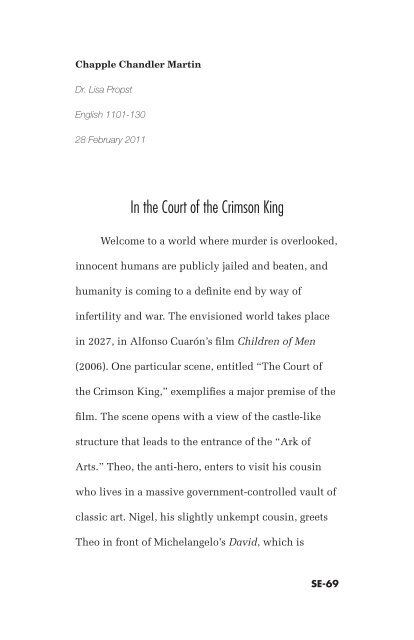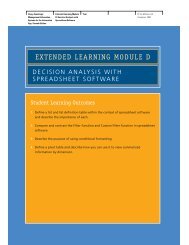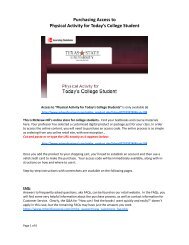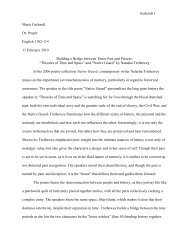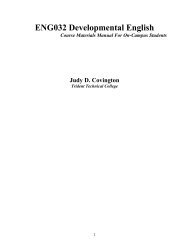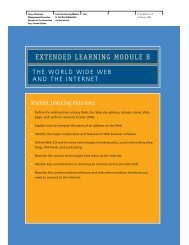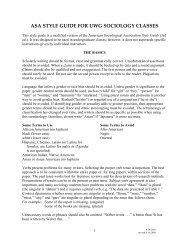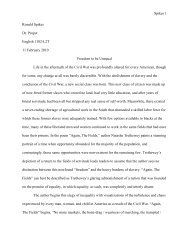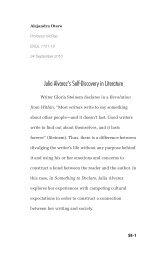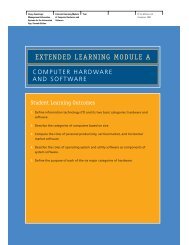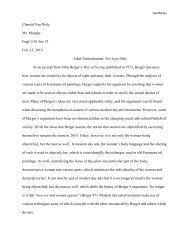In the Court of the Crimson King (Martin Essay)
In the Court of the Crimson King (Martin Essay)
In the Court of the Crimson King (Martin Essay)
You also want an ePaper? Increase the reach of your titles
YUMPU automatically turns print PDFs into web optimized ePapers that Google loves.
Chapple Chandler <strong>Martin</strong><br />
Dr. Lisa Propst<br />
English 1101-130<br />
28 February 2011<br />
<strong>In</strong> <strong>the</strong> <strong>Court</strong> <strong>of</strong> <strong>the</strong> <strong>Crimson</strong> <strong>King</strong><br />
Welcome to a world where murder is overlooked,<br />
innocent humans are publicly jailed and beaten, and<br />
humanity is coming to a definite end by way <strong>of</strong><br />
infertility and war. The envisioned world takes place<br />
in 2027, in Alfonso Cuarón’s film Children <strong>of</strong> Men<br />
(2006). One particular scene, entitled “The <strong>Court</strong> <strong>of</strong><br />
<strong>the</strong> <strong>Crimson</strong> <strong>King</strong>,” exemplifies a major premise <strong>of</strong> <strong>the</strong><br />
film. The scene opens with a view <strong>of</strong> <strong>the</strong> castle-like<br />
structure that leads to <strong>the</strong> entrance <strong>of</strong> <strong>the</strong> “Ark <strong>of</strong><br />
Arts.” Theo, <strong>the</strong> anti-hero, enters to visit his cousin<br />
who lives in a massive government-controlled vault <strong>of</strong><br />
classic art. Nigel, his slightly unkempt cousin, greets<br />
Theo in front <strong>of</strong> Michelangelo’s David, which is<br />
SE-69
SE-70 <strong>In</strong> <strong>the</strong> <strong>Court</strong> <strong>of</strong> <strong>the</strong> <strong>Crimson</strong> <strong>King</strong><br />
housed on <strong>the</strong> top story <strong>of</strong> <strong>the</strong> incredibly secure<br />
government high-rise. The pair sit for lunch at a long<br />
dining table adjacent to Picasso’s Guernica. <strong>In</strong> mid<br />
conversation, Nigel shouts at his son, who is sitting at<br />
<strong>the</strong> end <strong>of</strong> <strong>the</strong> table, urging him to take his pills,<br />
which is a noteworthy trend seen throughout <strong>the</strong> film.<br />
As <strong>the</strong> conversation ends, Theo walks to <strong>the</strong> great<br />
window overlooking <strong>the</strong> city <strong>of</strong> London and asks his<br />
cousin, “A hundred years from now, <strong>the</strong>re won’t be<br />
one sad [person] to look at any <strong>of</strong> this. What keeps you<br />
going?” Nigel’s reply encompasses <strong>the</strong> film’s <strong>the</strong>me in<br />
one short statement, “You know what it is, Theo? I just<br />
don’t think about it.” Using popular culture<br />
references, Children <strong>of</strong> Men is a political protest<br />
which challenges <strong>the</strong> unnoticed rise <strong>of</strong> ego-centric<br />
passivity in postmodern society and fur<strong>the</strong>r predicts<br />
that <strong>the</strong> consequences will be a complete disregard for<br />
human rights.<br />
During <strong>the</strong> “<strong>Court</strong> <strong>of</strong> <strong>the</strong> <strong>Crimson</strong> <strong>King</strong>” scene,<br />
Children <strong>of</strong> Men spotlights <strong>the</strong> result <strong>of</strong> ego-centric
<strong>In</strong> <strong>the</strong> <strong>Court</strong> <strong>of</strong> <strong>the</strong> <strong>Crimson</strong> <strong>King</strong><br />
SE-71<br />
passivity, using symbolic artwork and placement <strong>of</strong> art<br />
in relation to <strong>the</strong> characters. Michelangelo’s David is<br />
center-screen behind Theo’s cousin when <strong>the</strong>y first meet<br />
in <strong>the</strong> scene. David is a classic Florentine sculpture <strong>of</strong><br />
<strong>King</strong> David, designed to depict a “virtuous fighter for<br />
freedom,” describes <strong>the</strong> Oxford Dictionary <strong>of</strong> Art<br />
(“Michelangelo”). <strong>King</strong> David is also a well-known<br />
Biblical figure from <strong>the</strong> book <strong>of</strong> I Samuel, who defeats<br />
<strong>the</strong> giant “Goliath.” He is <strong>the</strong> image <strong>of</strong> an ideal man,<br />
who fought for a country’s freedom (“Michelangelo”).<br />
Nigel’s body movement, just for an instant, resembles<br />
David. As he enters <strong>the</strong> scene, he stands in front <strong>of</strong> <strong>the</strong><br />
statue and for a moment, shifts his weight into <strong>the</strong> same<br />
body position as David. Nigel’s trophy <strong>of</strong> status, David,<br />
is resembled through his body movement. Children <strong>of</strong><br />
Men uses irony here to contrast Nigel’s pride in <strong>the</strong><br />
sculpture with <strong>the</strong> contradicting essence <strong>of</strong> David who<br />
stands for <strong>the</strong> people. His greed is revealed throughout<br />
<strong>the</strong> scene through his collection <strong>of</strong> famous works <strong>of</strong> art.<br />
Even in <strong>the</strong> next instance, while smiling, he boasts <strong>of</strong>
SE-72 <strong>In</strong> <strong>the</strong> <strong>Court</strong> <strong>of</strong> <strong>the</strong> <strong>Crimson</strong> <strong>King</strong><br />
his importance by exclaiming, “Tried to save La Pieta!<br />
But it was all smashed up when I got <strong>the</strong>re.” Without<br />
literally saying <strong>the</strong> words, Nigel states that in his most<br />
heroic efforts, even he could not save such a precious<br />
work <strong>of</strong> art. The work <strong>of</strong> art referred to is <strong>the</strong> sculpture<br />
<strong>of</strong> <strong>the</strong> Virgin Mary cradling <strong>the</strong> crucified Christ Jesus in<br />
her arms. By mentioning <strong>the</strong> sculpture being smashed,<br />
<strong>the</strong> film notes <strong>the</strong> uprising rebellion <strong>of</strong> youth,<br />
continually rejecting faith and goodness. Nigel<br />
disregards <strong>the</strong> part <strong>of</strong> <strong>the</strong> story about unruly youth<br />
destroying a classic work <strong>of</strong> art; instead he continues to<br />
boast <strong>of</strong> his esteemed role in <strong>the</strong> world. <strong>In</strong> whole, Nigel’s<br />
role, in relevance to <strong>the</strong> art he refers to in <strong>the</strong> scene,<br />
points to <strong>the</strong> film’s <strong>the</strong>me <strong>of</strong> ego-centric passivity.<br />
Reflected in <strong>the</strong> scene’s artwork, <strong>the</strong> film<br />
expresses <strong>the</strong> extent to which Capitalism and Neo-<br />
Fascism, a political approach that uses physical force<br />
and control to achieve desired results (“Neo-fascist”),<br />
can destroy humanity. Pablo Picasso’s Guernica is<br />
displayed on <strong>the</strong> wall behind Theo at <strong>the</strong> dining table.
<strong>In</strong> <strong>the</strong> <strong>Court</strong> <strong>of</strong> <strong>the</strong> <strong>Crimson</strong> <strong>King</strong><br />
SE-73<br />
<strong>In</strong> its time and place <strong>of</strong> origin, <strong>the</strong> famous painting <strong>of</strong><br />
genocide was highly controversial (Alexandrou). The<br />
placement <strong>of</strong> <strong>the</strong> camera creates a medium shot,<br />
framing Guernica as a dystopia, an unbearable state <strong>of</strong><br />
chaos, encompassing Theo. Toge<strong>the</strong>r, Theo and<br />
Guernica represent a body <strong>of</strong> people in a Capitalist<br />
economy: <strong>the</strong> passive working class, uneager to<br />
acknowledge <strong>the</strong> inhumanity surrounding <strong>the</strong>m. Nigel<br />
sits directly across from Theo, facing Guernica, but<br />
does not care to acknowledge <strong>the</strong> extravagant painting.<br />
Here, Nigel is symbolic <strong>of</strong> <strong>the</strong> o<strong>the</strong>r half <strong>of</strong> capitalist<br />
economies: <strong>the</strong> wealthy men holding power, who<br />
choose not to extend sympathy to <strong>the</strong> oppressed<br />
working class. The two conflicting sides in an extreme<br />
situation, as <strong>the</strong> film illustrates, rely on one ano<strong>the</strong>r<br />
yet cannot function peacefully as a society. <strong>In</strong> fact, <strong>the</strong><br />
opposite <strong>of</strong> peace takes place: <strong>the</strong> struggle for power<br />
results in death and inhumane treatment <strong>of</strong> man.<br />
The camera work employed in “The <strong>Court</strong> <strong>of</strong> <strong>the</strong><br />
<strong>Crimson</strong> <strong>King</strong>” allows <strong>the</strong> audience to perceive details
SE-74 <strong>In</strong> <strong>the</strong> <strong>Court</strong> <strong>of</strong> <strong>the</strong> <strong>Crimson</strong> <strong>King</strong><br />
<strong>of</strong> Nigel’s son, Alex, a representation <strong>of</strong> ego-centric,<br />
passive youth in postmodern society, but who depicts<br />
an essential group to societal balance that has <strong>the</strong><br />
ability to change for good. Dialogue begins as <strong>the</strong><br />
camera views an extreme close up <strong>of</strong> Alex’s hand,<br />
which is wired up to a small video game. On his wrist<br />
is <strong>the</strong> bracelet connected to <strong>the</strong> wires as well as his<br />
personal identification bracelet. The audience can see<br />
that his elegant plate <strong>of</strong> food has yet to be touched. The<br />
camera <strong>the</strong>n cuts to a side shot, revealing a small cross<br />
tattooed on <strong>the</strong> back <strong>of</strong> his hand and <strong>the</strong> screen <strong>of</strong> <strong>the</strong><br />
video game responding to <strong>the</strong> boy’s moving fingers.<br />
The camera <strong>the</strong>n pans up to fix on a medium shot <strong>of</strong><br />
Alex, who is expressionless and fully concentrated on<br />
his game. The frame cuts to a wide shot that shows <strong>the</strong><br />
entire dining table and room where everything is<br />
painted in hopeless gray tones. Through <strong>the</strong> entire<br />
conversation between Theo and Nigel, Alex never<br />
looks up from his game, never speaks, and never even<br />
acknowledges his uncle’s presence. He completely
ignores <strong>the</strong> world around him to indulge in a self-<br />
gratifying activity. <strong>In</strong> his analysis <strong>of</strong> Children <strong>of</strong> Men,<br />
Tzvetan Todorov explains <strong>the</strong> link between passive<br />
youth culture and dwindling <strong>of</strong> humanity:<br />
We absorb culture through education . . . it<br />
is related to our language, <strong>the</strong>n to different<br />
landscapes that we live in. What happens<br />
is, during migrations <strong>of</strong> populations, <strong>the</strong>y<br />
lose initial culture, especially <strong>the</strong> younger<br />
ones . . . <strong>the</strong>y don’t acquire new culture.<br />
Now this is <strong>of</strong> course a huge danger<br />
because it is <strong>the</strong> destruction <strong>of</strong> <strong>the</strong>ir<br />
humanity. (“Possibility”)<br />
<strong>In</strong> <strong>the</strong> <strong>Court</strong> <strong>of</strong> <strong>the</strong> <strong>Crimson</strong> <strong>King</strong><br />
SE-75<br />
Children <strong>of</strong> Men pushes <strong>the</strong> thought that as globalized<br />
society increases, cultures will die (“Possibility”). The<br />
outcome will <strong>the</strong>n be a passive ego-centric youth<br />
culture which Alex represents. As a result <strong>of</strong> <strong>the</strong>ir<br />
passivity, <strong>the</strong> underlying problems <strong>of</strong> Alex’s
SE-76 <strong>In</strong> <strong>the</strong> <strong>Court</strong> <strong>of</strong> <strong>the</strong> <strong>Crimson</strong> <strong>King</strong><br />
generation continue to get ignored, and more serious<br />
problems develop. The majority <strong>of</strong> <strong>the</strong> film brings to<br />
light <strong>the</strong> political direction in which <strong>the</strong> world is<br />
headed and consequences that result (“Possibility”).<br />
Children <strong>of</strong> Men quietly references specific pop-<br />
culture images in order to visually illustrate how<br />
damaging pop-culture messages can be and to<br />
reinforce <strong>the</strong> central argument <strong>of</strong> <strong>the</strong> film, while<br />
speaking directly to <strong>the</strong> youth. During <strong>the</strong> “<strong>Court</strong> <strong>of</strong><br />
<strong>the</strong> <strong>Crimson</strong> <strong>King</strong>” scene, Nigel spends a lot <strong>of</strong> time<br />
overlooking his “kingdom.” The industrial cityscape,<br />
including <strong>the</strong> power station smokestacks and a giant<br />
floating pig balloon, actually mirrors an album cover<br />
by Pink Floyd entitled “Animals.” The album’s<br />
concept was conceived by Roger Waters, <strong>the</strong> British<br />
Progressive-Rock band’s lead vocalist, who, in an<br />
interview with Rolling Stone magazine states, “I loved<br />
Battersea Power Station as a piece <strong>of</strong> architecture, and<br />
it had good symbolic connections to Pink Floyd. It<br />
symbolized our decaying rock group.” <strong>In</strong> reference to
<strong>In</strong> <strong>the</strong> <strong>Court</strong> <strong>of</strong> <strong>the</strong> <strong>Crimson</strong> <strong>King</strong><br />
SE-77<br />
<strong>the</strong> floating pig from <strong>the</strong> cover, which was also<br />
displayed at shows, he says, “The pig came down in<br />
flames every night” (“Floyd’s”). The British journal,<br />
Critical Quarterly, connects similar movements heard<br />
in Leftist music in <strong>the</strong> 1960s, “<strong>the</strong> desert home <strong>of</strong> <strong>the</strong><br />
capitalist pig is blown up . . . and we see, . . .<br />
accompanied by a spacy and sinister Pink Floyd<br />
music track, . . . <strong>the</strong> whole commodity universe <strong>of</strong> late<br />
Capitalism . . . float by” (Beverley). Fans believe that<br />
<strong>the</strong> floating pig references George Orwell’s Animal<br />
Farm however, <strong>the</strong> book criticizes <strong>the</strong> opposite type <strong>of</strong><br />
extreme government. Animal Farm is commonly<br />
known to be a political satire on Communism; Pink<br />
Floyd’s pig criticizes <strong>the</strong> o<strong>the</strong>r extreme political<br />
ideologies <strong>of</strong> Neo-Fascism and Capitalism, as<br />
explained in Critical Quarterly, using a parallel<br />
illustration <strong>of</strong> animals. Analyzed in “A Revolution on<br />
Animal Farm,” V.C. Letemendia explains, “By<br />
revealing <strong>the</strong> divisions within <strong>the</strong> animal ranks,<br />
Orwell is cautioning his reader to question <strong>the</strong> animal
SE-78 <strong>In</strong> <strong>the</strong> <strong>Court</strong> <strong>of</strong> <strong>the</strong> <strong>Crimson</strong> <strong>King</strong><br />
view <strong>of</strong> <strong>the</strong> class struggle, for <strong>the</strong> crucial problem<br />
that . . . <strong>the</strong> real enemy is <strong>the</strong> power-hunger <strong>of</strong> <strong>the</strong><br />
pigs” (Letemendia 133). <strong>In</strong> a Communist situation like<br />
George Orwell’s book illustrates, <strong>the</strong> “pigs” would say<br />
that “all animals are equal,” when <strong>the</strong>y secretly<br />
attempt to gain control over all o<strong>the</strong>r animals and<br />
especially <strong>the</strong> humans. The satirical allegory, at times<br />
expressed by Pink Floyd’s pig to criticize Capitalism,<br />
is that <strong>the</strong> working “horses,” mindless “sheep,”<br />
violent “dogs” and powerful “pigs” are always in<br />
competition. One or two groups are always<br />
maintaining complete control, and sometimes<br />
subsidiary groups rise above <strong>the</strong> rest <strong>of</strong> <strong>the</strong> oppressed<br />
classes. Waters’ ideals align with <strong>the</strong> ideals <strong>of</strong> <strong>the</strong> film<br />
and <strong>the</strong> symbol <strong>of</strong> <strong>the</strong> pig in Children <strong>of</strong> Men. The pig<br />
balloon is placed in <strong>the</strong> background to represent <strong>the</strong><br />
strength and pride <strong>of</strong> <strong>the</strong> controlling, powerful “pigs”<br />
in 2027. The film hints that if Fascist “pigs” come to<br />
power, inhumane acts and killing will rise due to a<br />
controlling regime. <strong>In</strong> <strong>the</strong> commentary, “The
Possibility <strong>of</strong> Hope,” Slavoj Zizek says, “The main<br />
mode <strong>of</strong> politics [and] how you mobilize people is<br />
fear: fear <strong>of</strong> immigrants, even leftists, fear <strong>of</strong> too strong<br />
state, fear <strong>of</strong> taxation.” The “pigs” are a group with<br />
power obtained by wealth and ownership, but <strong>the</strong>y<br />
use <strong>the</strong> “dogs” <strong>of</strong> society to facilitate violence and fear,<br />
in order to achieve <strong>the</strong>ir agenda. <strong>In</strong> <strong>the</strong> film, it is<br />
apparent that certain groups <strong>of</strong> “dogs” are rising up<br />
against <strong>the</strong> “pigs,” while <strong>the</strong> working “horses” and<br />
mindless “sheep” just ignore it all. The ironic twist,<br />
however, is that <strong>the</strong> “dogs” want freedom from<br />
control, but <strong>the</strong>y are using control to get it. From <strong>the</strong><br />
view <strong>of</strong> Children <strong>of</strong> Men, as Zizek interprets, <strong>the</strong> fight<br />
for humanity will always be linked with <strong>the</strong> continual<br />
battle <strong>of</strong> control (“Possibility”). No longer should <strong>the</strong><br />
young allow society to crumble, but future generations<br />
must realize <strong>the</strong>ir integral part in society on a large<br />
scale and must instigate change.<br />
<strong>In</strong> <strong>the</strong> <strong>Court</strong> <strong>of</strong> <strong>the</strong> <strong>Crimson</strong> <strong>King</strong><br />
SE-79<br />
Children <strong>of</strong> Men uses art, pop-culture, and camera<br />
work to express a protest against ego-centric passivity.
SE-80 <strong>In</strong> <strong>the</strong> <strong>Court</strong> <strong>of</strong> <strong>the</strong> <strong>Crimson</strong> <strong>King</strong><br />
The specific references call youth to recognize <strong>the</strong><br />
movement <strong>of</strong> postmodern society and to become<br />
cautious <strong>of</strong> political trends toward Neo-Fascism and<br />
Capitalism. This method <strong>of</strong> visual reference relates to<br />
<strong>the</strong> youth audience and brings light to problems<br />
progressing and <strong>the</strong> corrosive effects <strong>the</strong>y have on<br />
culture. Humanity is only present on one planet, and<br />
Children <strong>of</strong> Men speaks out on <strong>the</strong> need to preserve it<br />
by beginning with positive development in youth<br />
culture, adapting with globalization, and continually<br />
balancing power within society. The brilliant details in<br />
<strong>the</strong> background <strong>of</strong> <strong>the</strong> film commonly go unnoticed by<br />
viewers, which echoes <strong>the</strong> same trend in ego-centric<br />
passivity: a disregard for <strong>the</strong> surrounding environment.<br />
Children <strong>of</strong> Men is just <strong>the</strong> tip <strong>of</strong> <strong>the</strong> iceberg <strong>of</strong><br />
recognition needed for major changes in global society.<br />
<strong>In</strong> hopes that youth will realize how important <strong>the</strong><br />
changes are, <strong>the</strong> film is one <strong>of</strong> many efforts to prompt<br />
youth to be <strong>the</strong> positive progress <strong>the</strong> world needs in<br />
order for humanity to survive.
Works Cited<br />
Alexandrou, Alex. “Guernica, bombing <strong>of</strong>.” The<br />
Oxford Companion to Military History. Ed.<br />
Richard Holmes. Oxford University Press,<br />
2001. Oxford Reference Online. Oxford<br />
University Press. Web. 28 February 2011.<br />
Beverley, John, 1943-. “The Ideology <strong>of</strong> Postmodern<br />
Music and Left Politics.” Postmodern Culture 1.1<br />
(1990). Project MUSE. Web. 21 Jan. 2011.<br />
Children <strong>of</strong> Men. Dir. Alfonso Cuarón. Perf. Clive<br />
Owen and Julianne Moore. Universal Pictures,<br />
2007. DVD.<br />
“Floyd’s Pig Crashes at Coachella.” Rolling Stone 29<br />
May 2008: 18. Academic Search Complete.<br />
EBSCO. Web. 12 Feb. 2011.<br />
Letemendia, V.C. “Revolution on Animal Farm.”<br />
Journal <strong>of</strong> Modern Literature 18.1 (1992):<br />
127-137. Academic Search Complete. EBSCO.<br />
Web. 12 Feb. 2011.<br />
<strong>In</strong> <strong>the</strong> <strong>Court</strong> <strong>of</strong> <strong>the</strong> <strong>Crimson</strong> <strong>King</strong><br />
SE-81
SE-82 <strong>In</strong> <strong>the</strong> <strong>Court</strong> <strong>of</strong> <strong>the</strong> <strong>Crimson</strong> <strong>King</strong><br />
“Michelangelo.” The Oxford Dictionary <strong>of</strong> Art. Ed. Ian<br />
Chilvers. Oxford University Press, 2004.<br />
Oxford Reference Online. Oxford University<br />
Press. Web. 28 February 2011.<br />
“neo-fascist.” The Canadian Oxford Dictionary. Ed.<br />
Ka<strong>the</strong>rine Barber. Oxford University Press<br />
2004. Oxford Reference Online. Oxford<br />
University Press. Web. 28 February 2011.<br />
“The Possibility <strong>of</strong> Hope.” Special Feature. Children <strong>of</strong><br />
Men. Dir. Alfonso Cuarón. Perf. Clive Owen and<br />
Julianne Moore. Universal Pictures, 2007. DVD.


